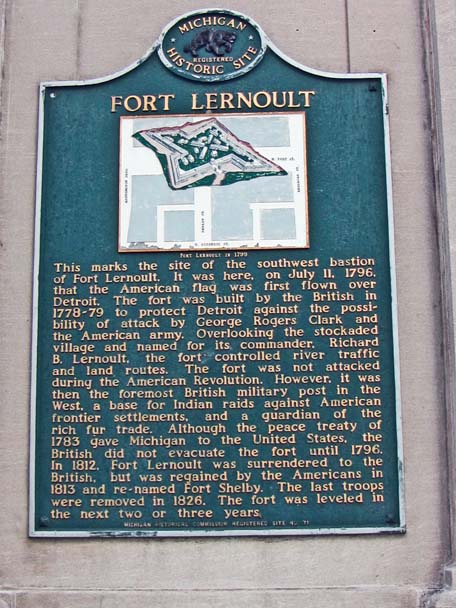

After British troops defeated French forces near Quebec City and Montreal in 1760, the French were losing their fight to control North American colonies. British Major, Robert Rogers, led a force from the British fort at Pittsburgh toward Detroit in the fall of 1760, anticipating an attack upon the French fort. In his journey, he learned from Ottawa Indians of the defeat of French forces in Quebec, so when the British arrived in Detroit on November 19, 1760, Francois Marie Picote de Belestre surrendered Fort Ponchatrain.
The French in Detroit tried to maintain friendly relations with the Indians and to covert them to European mores and Catholicism. The British were primarily interested in commercial trade with the Indians in hopes of securing valuable furs. Apparently, the British quickly antagonized the Indians. Detroit, at this time, was a primarily French village, although there were Scottish and English traders. Fearing that the French might join the Indians in an uprising against their rule, the British sought to take away the guns of the French, an unpopular move since Detroit residents relied upon game for their food. The British renamed the fort: Fort Detroit.
Ottawa Chief Pontiac organized most Indian tribes in the upper Midwest into a coordinated attack upon the British with plans to expel them so that Indians could claim their ancestral lands. Coordinated attacks were planned for the spring of 1763 against British forts at Detroit, Green Bay, Mackinac, Sandusky and St. Joseph. Pontiac himself intended to lead the attack on Fort Detroit beginning May 8, 1763. British intelligence learned of the Indians’ planning and devised an effective defense. Nevertheless, Pontiac led a siege of Fort Detroit that last from early May to the end of October, 1763. During the summer, the Indians effectively cut off the resupply of Fort Detroit and attacked British forces that sought to bring aid to the fort through Canada. By October, Pontiac learned that the Treaty of Paris officially ended French colonization in North America. He correctly assumed that he could no longer count on any French support in his fight to remove the English. Thus, he withdrew his troops from Detroit to the banks of the Maumee. Interestingly, the Indians were successful in overrunning the British forts at the other four locations. Detroit was the only fort the British could defend.
Early in the American Revolution, American forces sought to
attack the British in Canada. Revolutionary troops invaded Lower Canada,
fought with the British
near Quebec City and briefly occupied Montreal. Most of the fighting in the
War for Independence took place along the East Coast or on the Atlantic, but
Revolutionary troops occupied the fort at Pittsburgh. Fearing an attack upon
Detroit, the
British commander, Captain Richard Lernoult, ordered that a new fort be built
in 1778-1779. This is the structure commemorated by the historical marker shown
above. The American Revolutionary, George Rogers Clark, attempted to raise
a force that would attack the British in Detroit but was not successful in
his efforts so Fort Lernoult played no role in the Revolutionary War.
The peace treaty ending the US war of Independence in1783 called for the British
to cede control of Michigan, but they were in no hurry to leave. Instead, the
British supplied Indians who sought to kill Americans who increasingly settled
in Ohio and Indiana and Independence. This bloodshed increased and President
Washington reluctantly came to realize that there was another stage of the
Revolutionary War that must be fought. In 1792, he appointed General Anthony
Wayne to fight the Indians and their British allies in what came to be known
as the Northwest Indian War. The Battle of Fallen Timbers, near Toledo in August,
1794, was a key turning point since the Indians were defeated by US troops.
Realizing that their Indian allies had been overwhelmed, the British peacefully surrendered Fort Lernoult to American troops, led by Colonel Jean Francois Hamtramck, on July 11, 1796. The United States has occupied Detroit since that date with the exception of a brief period in 1813-1813 when the fort was surrendered to the British without a fight. After retaking the Fort in 1913, the American renamed it Fort Shelby in honor of the governor of Kentucky who successfully recruited troops to fight in the Midwest for the United States in the War of 1812. American troops continued to use Fort Shelby until 1826. It was then torn down.
In 1962, excavation started for the foundation of the Detroit Bank and Trust Building on the site of former Fort Lernoult. Those doing the digging recognized artifacts from the military base. Archeologists from Wayne State, I believe, supervised a careful retrieval of items from the fort, such as posts, ceramic chips, glass and pieces of metal. Apparently an archeological archive at Wayne State now contains 8,000 items from the Fort Lernoult that served the British and the Americans from 1878 to 1826.
State of Michigan Registry of Historic Sites:
State of Michigan Historical Marker
National Register of Historic Places:
Photograph: Ren Farley